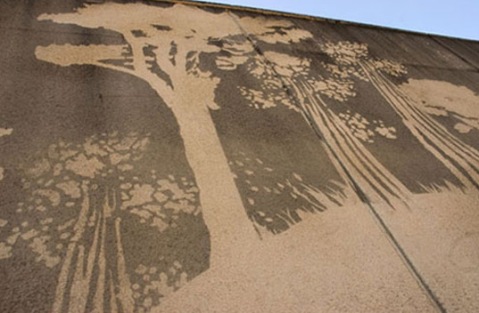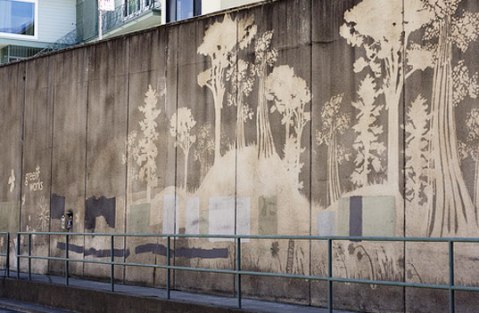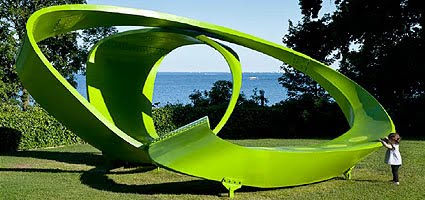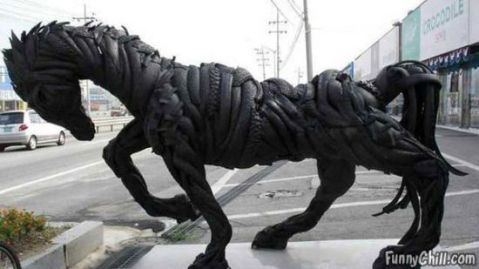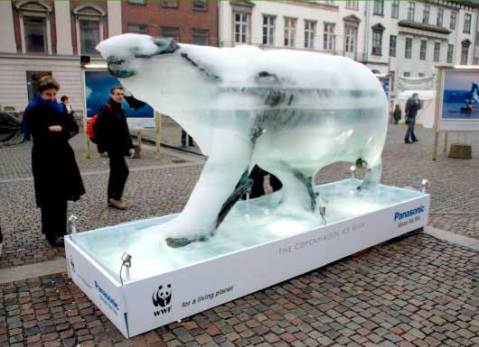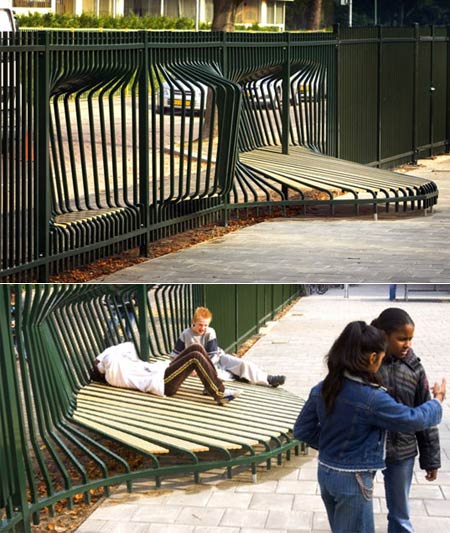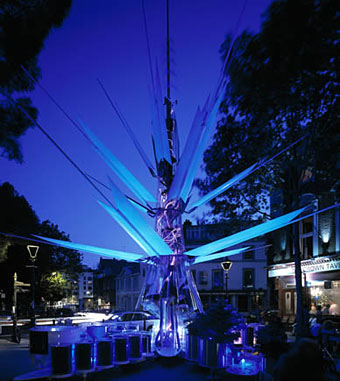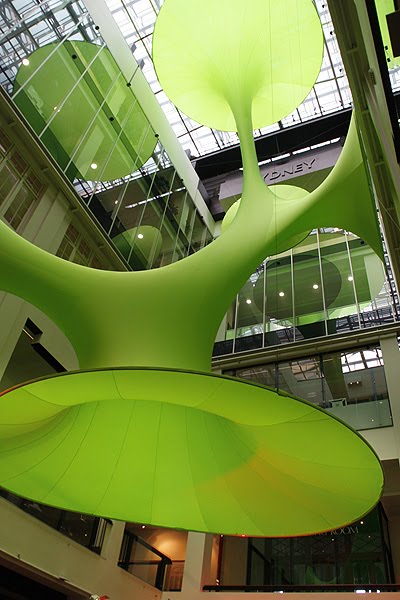Reverse Graffiti
Graffiti is one of the most controversial art forms out there since it defaces public property. Well a group of students from Durban, South Africa have a different outlook on the popular art form. What if graffiti artists actually cleaned up the walls by etching their sketches into the grime that already exists on them. They named this process, reverse .
I think that this is an amazing innovation to street art. It’s so dramatic and although graffiti has real attitude and personality i think this is a real strong competitor. Everyone notices street art what a great form of advertising this would be with no harm to the enviroment at all. This definitely has appeal. Is it the role of the designer to challenge traditional methods art for new contemporary ways.
Just a few things……
The Pavillion
This sculpture is made of natural materials and was on display for the 2009 UN Climate Conference in Copenhagen and received a JEC Innovation Award for showing cutting edge possibilities of using sustainable and intelligent materials in design. The artwork was created by 3XN architects together with StageOne Freeform Composite, Skykon and COWI.
“We believe the future is with new materials that require less energy to produce than aluminium or concrete. And now we hope that the knowledge gained from the project can be used in other applications, and possibly in other industries.” Kim Herforth Nielsen, founder of 3XN
“It is fascinating to think that, with the right materials, human activity can be converted into useable energy, just as when kids playing on the pavilion illuminate its integrated LED lights. The pavilion has made it possible for us to demonstrate how sustainable and intelligent materials can be used as construction materials.” COWI R&D Director Bente Andersen.
A project like this offers new answers to environmental concerns often raised when using materials such as polyester, glass fibres,concrete etc. There is a growing need for the composite industry to find answers to energy consumption during production and to the recycling process. this project offers an environmentally friendly solution. This project promotes innovation if designers can produce amazing sculptures like this with eco-friendly materials for the same price shouldnt we all be considering this!!!
Tyre Horse Sculpture by Jeff koons.
This sculpture is made purely from recycled tyres. I thought i would put this on because i think it looks awesome, it would definitely stop me in the street.
Mark Coreth’s polar bear
The Ice Bear Project create sculptures that inspire audiences everywhere to make a connection with the Arctic. They are life size polar bears in ice with a bronze skeleton. As the public are encouraged to touch the sculpture, their actions impact by warming the ice and the polar bear melts to its metal skeleton on a shrinking iceberg.
I think this idea is extremely innovative in ways that the audience can get involved with the art and its environmental messages it stands for. This is definitely breaching the boundaries this is a piece of art that people can interact with and that they can change and have an impact on. I love this idea it is definitely more thought provoking than that of a boring poster that probably wouldn’t get noticed. How could you not notice this. This particular image was one of the sculptures placed in Copenhagen outside the climate change summit last year.
http://www.icebearproject.org/
Masking more out of less it’s a seat a fence and a sculpture. Brilliant!!
London Oasis
London Oasis designed by architect Laurie Chetwood. The Oasis is a demonstration of sustainability and renewable energy working with architecture to provide a tranquil oasis for London. The 12 metre high structure mimics the design of a growing flower: its “petals” open and close in response to the sun and the moon utilising daylight to generate power. It also contains a hydrogen fuel cell and wind turbine to make it self-sufficient. It even uses rainwater it has collected for irrigation and cooling. Inside the petals, there are five “people pods,” which visitors pull down over their heads. Once enclosed, they can retreat from the busy streets to breathe clean, cooled air while relaxing to music and bird songs. The Oasis interacts with the environment around it. It senses time, the weather and people, and responds accordingly. At night, it uses energy stored during the day to power a beacon in the form of a light show which responds to the movement of people around.
Again this is another piece of art that its “visitors” can interact with and can use guilt free knowing that its self efficient and not creating any harm to the enviroment. Perhaps it is the role of the designer to create design that people can use or enjoy with feeling no guilt for the enviroment.
http://www.msnbc.msn.com/id/13436983/
The Green Sculpture
Architects from LAVA thought up this installation in a five floor shopping centre in Sydney. The sculpture is 20 metres in height and consists of easy fabric tense on an aluminium basis. The main reason I liked this piece is the fact that it utilises the space provided with minimal wastage its definitely a big statement.
UNICEF
Children around the world are having their rights denied every day. UNICEF is working in 193 countries to protect these rights making sure children’s voices are heard and listened to. UNICEF relies on voluntary donations to fund our vital work for children and their rights. They receive no funding from the UN budget. UNICEF UK raises funds for these programmes through donations, the sale of cards and gifts, partnerships with companies and special events.
UNICEF story: Shumon 13, lives in a slum in Bangladesh and works seven hours a day making pots in an aluminium factory. Unlike other children his age, he has no time to go to school. “At work I sometimes hurt my hands, which is really painful.” He is under pressure to work fast because he is paid by the number of pots he can produce and his family desperately needs the money.
Is this ethically correct?? Of course it’s not but yet it still happens. What can we do as designers to prevent child labour, probably nothing as it’s a way of life in under developed countries but just because of this does that mean we shouldnt try. In my eyes, no not at all if i could do something as a designer to help destroy this way of life for children I would and I would not expect to be paid!!! Although not all people and designers would think in this way.
UNICEF works to give children rights as they have the right to have them just like all of us. If they knew different their ethical outlook on the situation would in no doubt change.
How can we help?? whether it be a donation or a design campaign to promote the charity every little helps. Would designers want to get involved with a charity such as this? Well I remember Gareth Lawn claiming that he wouldn’t feel comfortable designing a campaign for a charity as he would not want the responsibility if it did not succeed. This is a fair point to make although i think the effort is still needed and i would at least try!!
Say yes or no to work
“We are problem solving communicators but feel we cannot afford to turn down work (ethics or Not) in the early days of our careers!”
All humans have their own ethics and standards but could money stand in the way? I would like to say for the majority that money wouldn’t be an issue but there is a small minority where money would sway their thoughts and ethical core. I believe in standing for what you believe is true and in the future if a job was offered to me that I was not comfortable with in terms of my ethical standards I would most definitely turn it down regardless of money.
I think as a designer we have the right to choose what jobs you wish to take on and which you don’t. Designers are human you would not participate in something you dot agree with in your normal life enviroment so why should you within your work enviroment or worse still be expected to!!!
No Logo: taking aim at the brand bullies by Naomi Klein
The growth in the wealth and cultural influence of multi-national corporations over since the 1980’s can arguably be down to one idea: that successful corporations must primarily produce brands, as opposed to products. Until that time, the primary concern of every solid manufacturer was the production of goods. Had designers lost sight of actually making things. then along came the new rival corporations the Nike and Microsoft, and later, the Tommy Hilfiger and Intel. These pioneers made the bold claim that producing goods was only an incidental part of their operations, they were able to have their products made for them by contractors, many of them overseas. These companies produced primarily were images of their brands. Their real work lay not in manufacturing but in marketing. It’s all about who produces the best image not product.
Most of today’s well-known manufacturers no longer produce products and advertise them, but rather buy products and “brand” them. Manufacturing products may require physical tools, but creating a brand needs a completely different set of tools and materials. It requires an endless parade of branding, constant renewed imagery for marketing and, most of all, new space to advertise the brand itself essentially clogging up the landscape and enviroment with endless campaigns.
So the role of advertising changed from delivering news of a new product to building an image around a particular brand/name of a product. in the 1880’s corporate logos were introduced to mass produce goods such as sugar, flour, soap and cereal. Even from this point in life did the consumer buy the brand rather than the product. As we well know brand carry a hierarchy of status, only the rich would purchase the high end brands whereas the poor may choose to evaluate value before image. In a sense did the product begin to have a personality???
Can a product produce a feeling with its thoughtful imagery and comforting appealing design idea. essentially it is the brand that the consumers are buying as opposed to the product. The consumer is lulled into a false sense of security that perhaps they need to buy this brand to look good maybe!!
It took decades to realise what was going on companys clung to the idea that business was still purely for production and branding was simply an important add on. Right up until Phillip Morris bought Kraft in 1988 for 12.6 billion 6 times what the company was worth on paper. Apparently the price difference was solely for the name!! THE BRAND The way of thinking was now the more you spend on branding and advertising the more the company will be worth. Corporations such as Nike and Reebok wised up to the idea of sponsors. Using well known athletes as a walking brand for their products essentially broadening their strategy to this end of the “branding market.”
Arguably some could say that branding has died. Now companies may choose to put money into the marketing rather than the branding. Huge names such as Microsoft and Apple focus more on the product evolving and the practicalities rather than the name as this is what people want. Whereas companies such as Coca Cola, Disney, McDonald’s and Burger King rely solely on the name and choose to escalate as they have their eyes on global expansion only.
 A good example to mention is Body Shop over the years through 2 recessions they have been ever expanding without spending a penny on advertising whatsoever. Who need magazines and billboards when they can take advantage of their 3 dimensional retail outlet as a form of advertising an ethical, ecological approach to cosmetics. The Body Shop are all about the brand, yet they do it the right way.
A good example to mention is Body Shop over the years through 2 recessions they have been ever expanding without spending a penny on advertising whatsoever. Who need magazines and billboards when they can take advantage of their 3 dimensional retail outlet as a form of advertising an ethical, ecological approach to cosmetics. The Body Shop are all about the brand, yet they do it the right way.
 It can be argued we have approached a branding crisis but is there really a crisis or is it just lack of confidence in a product. The product always takes back seat to the brand this can only prove perhaps this isn’t the way forward if the product is good consumers will purchase regardless of the brand. On this hand it’s all about the reputation. For instance take Caterpillar renound for producing building machinery yet now they have expanded and released a branding campaign launching CAT accessories, boots, back packs, hats etc. If consumers have confidence in the product and its reputation of course they will buy.
It can be argued we have approached a branding crisis but is there really a crisis or is it just lack of confidence in a product. The product always takes back seat to the brand this can only prove perhaps this isn’t the way forward if the product is good consumers will purchase regardless of the brand. On this hand it’s all about the reputation. For instance take Caterpillar renound for producing building machinery yet now they have expanded and released a branding campaign launching CAT accessories, boots, back packs, hats etc. If consumers have confidence in the product and its reputation of course they will buy.
In my opinion brand is a lifestyle im sure lots of middle class students would love to own a pair of Hilfiger jeans but settle for a good reliable high street brand which are no worse than Hilfiger yet the brand says otherwise. In the present economic decline I think consumers are looking for a reliable fair product that is practical and do not want to pay huge amounts of money for a name that isn’t ethically correct in itself is it????
more lecture notes…….
The design community is part of a socio-economic system that contains limitless growth and a continual state of desire. While in a global context over 50% of human beings have an inadequate supply of the basic necessities of life: water, heating, lighting and survive on less than a dollar a day. So is it ethically correct to continue to function in a system in which designers use mass manipulation of people for financial gain as opposed to helping miss fortunate.
The Bauhaus set up the concept of the ‘one true type’ of object, choice and variety were unnecessary, because the modernists would be inventing the perfect or, optimum solution to a functional problem for every product humans would ever require. The design ethic being more about how designers thought people should live and not the way people do live. Design in the modern world was to be rational, unsentimental, functional and serious. (In my opinion this is a major failure in thought)
Post war period in the USA moved into high mass consumption stage. An era of advanced consumer society and became a model for other societies such as ours. The major problem for the designer with regards to this “new society” is to continually stimulating the urge to buy. Is this the Designers role? Most definitely the role of the designer is to stimulate the consumer to buy a product that’s their job and where their expertise lie. The design world is forever changing the designer has to just get bigger and better!! In a free enterprise capitalist system the only reason to use a designer is to increase the sales of a product, therefore it is the designers role to constantly further evolve their creative skills to produce a product more exciting and appealing to a heavily saturated consumer market.
Milton Glaser 10 points road to hell. Where do your ethics lie, as a designer what do you do and not do?? for example
- Designing an ad for a slow, boring film to make it seem like a light-hearted comedy.
- Designing a medal using steel from the World Trade Center to be sold as a profit-making souvenir of September 11th.
- Designing a line of T-shirts for a manufacturer that employs child labour.
Your decision would rely on your ethical makeup, your core values which give you meaning and value to your work. If we question our designer involvement; How do we square the spending and consuming as if there was no future cost attached. Is there such thing as sustainable design? Are we purely neutral transmitters of a clients message? If we are problem solvers should we be careful as to what problems we take on?
Is design a neutral value free process? No what about the useless material produced all the time pur waste such as brochures leaflets that just get thrown away. The rise of the Deadly Designers “who create a whole new species of permanent rubbish to clutter the landscape, and by choosing materials and processes that pollute the air we breathe, designers have become a dangerous breed.” Design for Society
The choice of client is crucial with regards to your ethical values. As a designer they must plan an ethical practice strategically be an informed, involved citizen, agile and flexible. Is it right for a designer to make moral judgements that interfere with the consumer’s right to choose for her or himself in a ‘free’ society. some designers argue that the interests of the client and the client’s customers are identical. This unconvincing argument is of the amoral designer who caters for desires but asks no further questions like is it socially beneficial, are resources wasted etc. BUT if design is a business this means that it holds its own power perhaps pushing the client further away creating dependency for themselves.
 Example: The Nazi logo is a good design it worked well for the nazi party but it does not make it ethically correct or right.
Example: The Nazi logo is a good design it worked well for the nazi party but it does not make it ethically correct or right.
OR Nestle for instance are known for the providing of free baby milk substitute to poor Third World mothers in hospitals, leading to dependency on the substitute and eventually to the deaths of millions of babies. At first Nestle tried to paint it as anti-capitalist propaganda, rather than addressing it. They claimed to be champions of the free market. This led to a boycott of Nestle products eventually leading Nestle into dialogue to try to resolve the issues. Over 30 years!
In terms of ethical consuming 50% of us operate some kind of boycott on the goods we purchase but it’s not straight forward or easy to work out who the ‘bad guys’ are… So it is easy to target Global Corporations such as……
- Nike – Child labour
- Gap – Worker exploitation
- Campbells Soup – Treatment of migrant workers
- McDonald’s – Destruction of the rainforest to graze cattle
Now do we do anything??? Today’s designers must rediscover the purpose of design as a social, moral and political force …we should grow in to active citizens, informed, concerned participant in society who happen to be designers.’ Keep your convictions and not be passive economic servants. Katherine McCoy.
Message from Milton Glaser
“The political exploitation of the fear of terrorism is as alarming as terrorism itself. It has caused me to examine my role as a citizen and to think about whether designers as a group have a dog in this fight, to use a pungent down home cliché. Our dog in this fight may be human survival.”
“As designers, we’ve been concerned about our role in society for a very long time. It’s important to remember that even modernism had social reform as its basic principle, but the need to act seems more imperative than ever.”
“I’ve also changed my mind again about my self designation. Designer/Citizen seems like a more satisfying description. There has been no better time for all of us to assume this role. We are all at risk, but like Victor Frankl, we can choose how to react to our circumstances. We can reject the passivity and narcissism that leads to despair, and choose to participate in the life of our times.”
What is everyone’s self designation? everyone varies with regards to opinion. If we are at risk how should we react to a social, economic or environmental situation. To improve life of our times we need to participate in the improvements of the world. The designer can essentially change the way a citizen thinks with the use of the designers resources and power over the consumers attention.
Lecture Notes
First Things First 200 a design manifesto (and my opinion)
we the designers are graphic designers, art directors, visual communicators in a world in which techniques of advertising are persistently presented to us as the most desireable use of our talents. Many promote this belief, the market rewards it and books reinforce it.
Encouraged by this belief designers can then apply their skill to sell anything from dog biscuits to cigarettes to trainers. this commercial work is what designers do and that is how the world perceives design. BUT is most of their energy wasted manufacturing for a demand of goods that are inessential at best. Is this view uncomfortable, do designers who commit to marketing and brand development work in an enviroment so saturated with commercial messages to the extreme it controls how consumers think and respond. As a designer are we helping to produce a harmful code of public control and discourse.
Perhaps other realms of design deserve our attention more so than the “inessential demand” such as environmental, social and cultural crises. Maybe a reversal of priorities is needed in favor of a more useful lasting communication, an exploration into a new kind of meaning. Designers can make a difference and it is their role to do so through their visual language and resources of design. Explosive growth of global commercial culture means this message gets stronger!!
